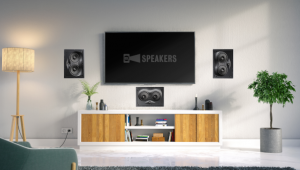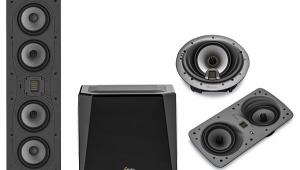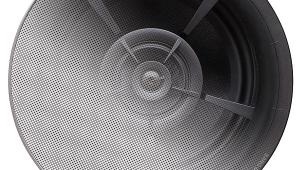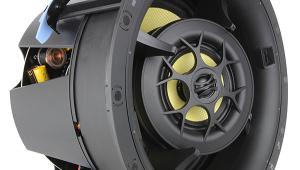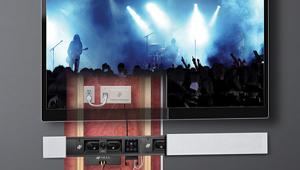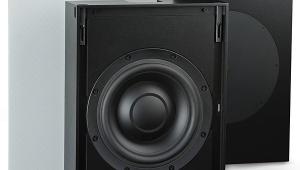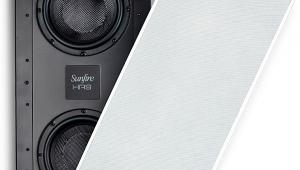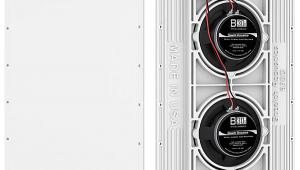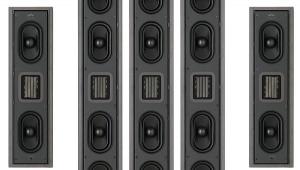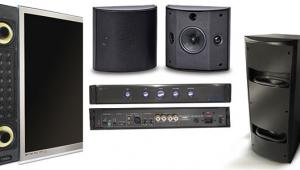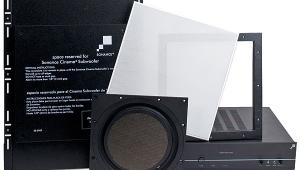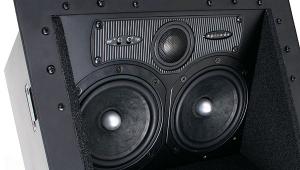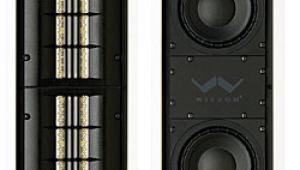Pioneer Elite EX Series S-IW691L In-Wall Speaker System Page 2
ever, these are generally intended for new construction rather than retrofit installations. If you use such an enclosure in a retrofit, you have to remove and often replace, patch, and paint more drywall.
I spoke with Jones about enclosures, and he told me that the Pioneer in-walls are tuned to operate in a cavity volume that’s roughly the size of a typical residential wall cavity for retrofit installations. He also explained that most people use in-wall speakers with a subwoofer and a crossover point of 80 hertz or higher, so it’s almost a moot point. Jones also mentioned that as the line grows, Pioneer may offer additional models with full enclosures.
The Pioneer speakers have white grilles that you can paint to match your room décor.
System Setup
My review samples consisted of three S-IW691L speakers, in a left, center, right-channel configuration. I installed them in portable testing walls that are designed to simulate a residential wall. The portable walls are approximately the same wall cavity volume found in a typical home, about 1.5 cubic feet. The design of the walls assumes that a residential wall includes a firebreak, a horizontal two-by-four installed midway up the wall to increase wall strength and prevent the spread of fire. As Pioneer (and most in-wall speaker manufacturers) recommends, I filled the cavity with R-13 insulation to dampen the sound waves coming from the rear of the drivers.

To complete the five-channel system, I used two Pioneer S-4EX speakers for the surround channels. The S-4EX is the cabinet or in-room version of the S-IW691L in-walls. It uses the same drivers and crossover components as the S-IW691L speakers, except the S-4EX uses one woofer instead of two.
Music and Home Theater Performance: Does Sonic Coherence Really Make a Difference?
I tested the Pioneer in-walls with a few of my reference audio discs and movies to find out. If transparency, detail, and midrange openness are a result of sonic coherence, then coherence makes a huge difference, especially with vocal tracks and film dialogue. The Pioneer S-IW691L is among the few in-walls I’ve heard that sound close to an in-room speaker.
I’ve seldom heard more detail when listening to “What’s a Little More Rain” by Sara K. (from Closer Than They Appear, Chesky Records). Her voice was extraordinarily open sounding, and the speakers resolved many subtle sonic details that I hadn’t noticed before. Her recording of “Miles Away” has a small bell that sounded clearer and more distinct than I ever remember hearing.
Each rolling “r” in “Cielito Lindo” by Marta Gomez (from Entre Cada Palabra, Chesky Records) seemed to stand out with pinpoint clarity that transcended the sensation of listening to a speaker. Only 7 feet separated the portable testing walls, but the soundstage sounded much wider and was accompanied by a prominent center image. I could easily separate the subtle sounds of fingers on the guitar strings and Gomez’s highly dynamic voice. It takes both a good recording and transparent loudspeakers to reproduce the subtleties of a musical performance. The combination of outstanding clarity and detail with a three-dimensional soundstage is a testament to the quality of Chesky recordings and the quality of the Pioneer speakers.
The same transparency and vocal details that characterized the sound of the Pioneer in-walls with music produced exceptional dialogue intelligibility in movie soundtracks. The Great Debaters (DVD) is a drama about a professor from Wiley College in Texas who coaches the school’s first debate team in 1935. The dialogue clarity of the Pioneer in-walls set them apart in the multiple debates that take place in various academic venues, particularly when the team debates against the Harvard team in a large hall.
The film sound also demonstrated the speakers’ impressive soundfield capabilities. The speaker system meticulously reproduced the subtle spatial cues that helped me feel the size and space of the small halls and large venues where the debates take place.
The same sense of spatiality was palpable in National Treasure 2: Book of Secrets (Blu-ray), a fictional tale about treasure hunters who seek to uncover the secrets behind Abraham Lincoln’s assassination. Their search for the truth leads them to the City of Gold, an ancient underground city located far beneath Mount Rushmore. As they reach the subterranean caverns, the speaker system and the Dolby TrueHD soundtrack connected the immense visual images with the audible cues of being in a large, cavernous space.
The speakers’ detailed sound qualities were easy to notice in The Invasion (Blu-ray), a take-off of Invasion of the Body Snatchers. Toward the end of the movie, Carol Bennell, a psychiatrist searching for her young son, is involved in a rather unbelievable car chase complete with multiple collisions that ends with a large collection of destroyed vehicles. The sounds of metal on metal can be harsh on the ears, but even at reference levels, the Pioneer speakers resolved all of the sonic details without sounding strident or overbearing.
My subjective impression was that the CST’s usable off-axis response extends to approximately 60 to 75 degrees, which is a broad enough sweet spot or prime listening position. For me, off-axis response is more important for movies, primarily because in my house movie watching is a family activity. Critical music listening usually just involves one person (me!) seated in the ideal location.
Conclusions
I took a quick mental inventory of the many reference speakers I’ve owned and enjoyed, and they’ve all employed various methods of achieving sonic coherence. Some used precise driver alignment, and others used a single driver for all frequencies, but the result was always the same. (If you’re interested, the Dahlquist DQ-10 and Ohm F speakers are two of them.) To my ears, sonic coherence is the most important aspect of music listening and home theater sound, and its subjective benefits are very real. Speakers that accomplish this can lift the veil that shrouds many speakers and rise above the sense of sound reproduction. They sound more like you would imagine the original performance.
By their very nature, in-wall speakers are subject to installation peculiarities that can potentially impact their performance. To overcome these limitations and offer performance commensurate with an in-room speaker is an uncommon engineering achievement. The Pioneer Elite EX S-IW691L speaker achieves uncommon results. You can cram all of the available technology into a speaker, but the real test is listening in real-world conditions. In this case, the Pioneer in-wall speakers aced the exam.

- Log in or register to post comments
